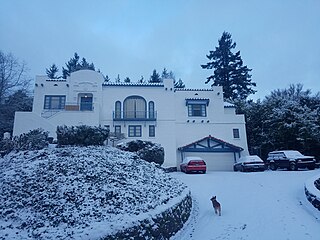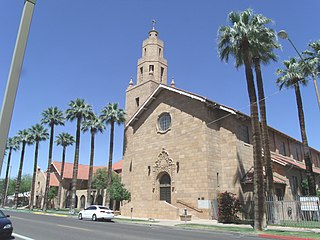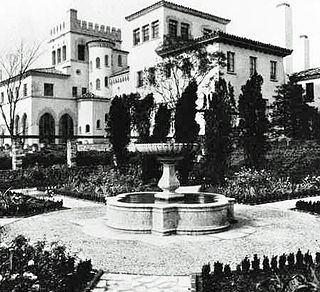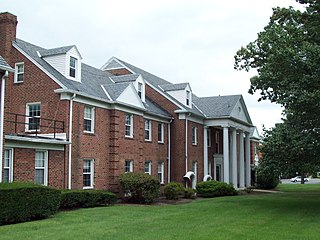 W
WThe Astoria Victory Monument, also known as the Doughboy Monument or Soldiers' Monument, is a monument located in Astoria, Oregon, in the United States. It is listed on the National Register of Historic Places. The concrete, Spanish Revival monument designed by Charles T. Diamond was constructed in 1926, incorporating a cast of a sculpture by John Paulding. The structure was recognized individually by the National Register of Historic Places in 1984 and as part of the Uniontown–Alameda Historic District in 1988.
 W
WThe Athletic Club of Columbus or ACC, is a private social club and athletic club in Columbus, Ohio, US. Located at 136 East Broad Street, it was founded in 1912.
 W
WThe Minor Basilica of St. Lawrence the Deacon & Martyr is a minor basilica of the Roman Catholic Church in downtown Asheville, North Carolina, United States. The church was designed and built in 1905 by Spanish architect Rafael Guastavino along with his fellow architect R. S. Smith and the Roman Catholic community of Asheville. Pope John Paul II elevated the status of the church to minor basilica in 1993. It is a parish church, located within the Diocese of Charlotte. It is on the National Register of Historic Places. It is the only basilica in western North Carolina. Its dome has a span of 58 by 82 feet and is reputed to be the largest, freestanding, elliptical dome in North America. Except for the foundation and brick walls, the architectural style is Catalan, with the main example being the stairs behind the altar. It is located in the Downtown Asheville Historic District.
 W
WThe Basilica Shrine of St. Mary is a Minor Basilica in the Catholic Church located in Wilmington, North Carolina, in the Diocese of Raleigh. It was included as a contributing property in the Wilmington Historic District on the National Register of Historic Places in 1974.
 W
WThe Bohnsen Cottages is a building complex located in southwest Portland, Oregon listed on the National Register of Historic Places.
 W
WCentral Park Theater is a historic theater building at 3531-39 W. Roosevelt Road in the Lawndale neighborhood of Chicago, Illinois. Built in 1917, the theater was the first in the Balaban and Katz chain. Chicago architectural firm Rapp and Rapp designed the Spanish Revival building; their design led them to become the main architects for Balaban and Katz, and later for Paramount Pictures. The firm's design featured two prominent towers on its front facade and was decorated with red brick and terra cotta. The theater was also the first in the world to include mechanical air conditioning, which featured prominently in its advertising during the summer. It provided entertainment to both Lawndale's Jewish community and the African-American community that replaced it in the 1950s, and it is one of the few remaining Lawndale business from the early twentieth century. The theatre was the inspiration for the well known Call of Duty Zombies map, Kino Der Toten.
 W
WThe Digman–Zidell House is a house located in southwest Portland, Oregon, listed on the National Register of Historic Places.
 W
WThe First Presbyterian Church in Phoenix, Arizona, is a historic church designed by architect Norman F. Marsh. Located at 402 W. Monroe Street, the church was built in 1927, in the Spanish Colonial Revival style. It was added to the National Register of Historic Places in 1993.
 W
WThe Fort Worth Stockyards is a historic district that is located in Fort Worth, Texas, north of the central business district. A 98-acre (40 ha) portion encompassing much of the district was listed on the National Register of Historic Places as Fort Worth Stockyards Historic District in 1976. It holds a former livestock market which operated under various owners from 1866.
 W
WThe Grand Central Public Market is a building in southeast Portland, Oregon. It was added to the National Register of Historic Places in 2006.
 W
WThe Julia Ideson Building is a Houston Public Library facility in Downtown Houston, Texas, United States. It is named for Julia Bedford Ideson, the first Head Librarian of the Houston Public Libraries, who served in that role for forty years.
 W
WJackson School, built in 1936, is located in Enid, Garfield County, Oklahoma and listed on the National Register of Historic Places since 1989. It is one of three Mission/Spanish Colonial buildings in Enid. The other two are the 1928 Rock Island Depot, also listed on the register, and the Ehly house, constructed in 1929 for local J.C. Penney's manager, Gus Ehly. The building is constructed using buff brick and cast stone decorative molding. It has two arched entry ways with red tile shed roofs, a Greek cross in the upper middle section, and cement staircases. The building encompasses Block 16 of Enid's Southern Heights second addition. Its architect Roy Shaw also designed several other Enid school buildings including Enid High School, Adams, Garfield, Roosevelt, and Longfellow. Jackson school served as an all-white school until Enid's schools integrated in 1959. From 1967 to 1969, Jackson and neighboring George Washington Carver, formerly an all-black school, split grades 1-3 and 4-6, respectively, between the two schools, until both were closed in 1969.
 W
WLa Ronda, was a mansion and estate in Bryn Mawr, Pennsylvania from 1929 to 2009. It was originally the home of Percival E. Foerderer, who ran a leather-manufacturing business, and his wife Ethel Brown. The 17,500-square-foot (1,630 m2) Main Line mansion was the last commission by the renowned early 20th century architect Addison Mizner based in Palm Beach, Florida. The residence was built by J.S. Cornell & Son.
 W
WThe Minnesota Boat Club Boathouse on Raspberry Island is the home of the Minnesota Boat Club, a rowing club founded in 1870. It is Minnesota's oldest athletic organization. The building was listed on the National Register of Historic Places in 1982 and is located in Saint Paul, Minnesota.
 W
WThe Orpheum Theatre is a 1364-seat theatre in downtown Phoenix. This venue was originally used for vaudeville acts as part of the nationwide Orpheum Circuit.
 W
WThe Charles Piper Building is a building in southeast Portland, Oregon listed on the National Register of Historic Places.
 W
WThe St. George Theatre is a performing arts venue, picture palace, and office complex at 35 Hyatt Street in St. George, on the North Shore of Staten Island, New York City. The 2,800-seat St. George Theatre was built for Staten Island theater operator Solomon Brill and opened on December 4, 1929.
 W
WSamuel Vaisberg House is a historic home located at Long Beach in Nassau County, New York. It was built in 1927 in the boom years before the Great Depression. It is a rectangular, 2 1⁄2-story, Spanish Revival-style residence with a stucco exterior and a clay tile, hipped roof. It features decorative art glass windows. Also on the property is a stucco garage.
 W
WThe West Riverdale Historic District is a national historic district located at Riverdale Park, Prince George's County, Maryland, a railroad suburb located northeast of Washington, D.C. The neighborhood was appended to the town of Riverdale Park soon after it was laid out and platted in 1906, and later enlarged in 1937. The district is defined by a modest variety of architectural styles and building types ranging from early-20th century vernacular interpretations of popular styles to diluted, suburbanized examples of revival styles that dominated the second quarter of the 20th century. These styles represent modest examples of Queen Anne, Colonial Revival, Spanish Colonial Revival, Craftsman, and Tudor Revival forms. At the center of the community is the former Eugene Leland Memorial Hospital, now known as the Crescent Cities Health and Rehabilitation Center.
 W
WThe Wrigley Building is a skyscraper located at 400–410 North Michigan Avenue on Chicago's Near North Side. It is located on the Magnificent Mile directly across Michigan Avenue from the Tribune Tower. It was built to house the corporate headquarters of the Wrigley Company.
 W
WThe Young–Almas House is a site on the National Register of Historic Places located in Havre, Montana.